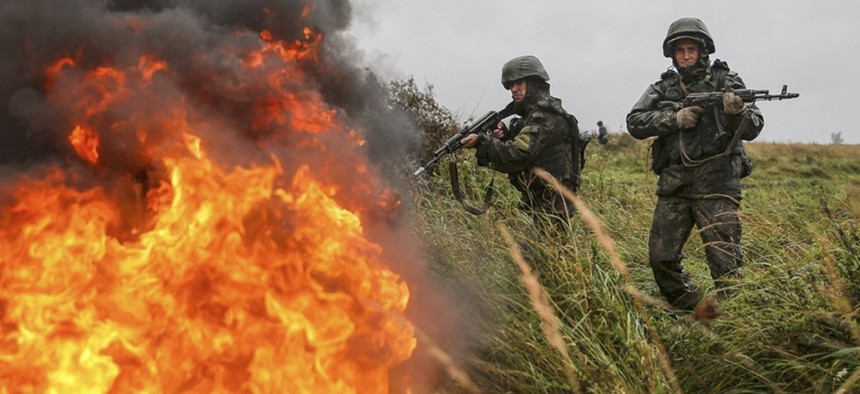
This photo provided Tuesday, Sept. 19, by Russian Defense Ministry official web site shows Russian troops during a military exercise at a training ground near Kaliningrad, Russia, Monday, Sept. 18, 2017. AP Photo/ Russian Defense Ministry Press Service
Russian Special Forces Just Practiced Invading an Island Near Finland
It’s the latest in a series of military exercises that regional observers call provocative and intimidating.
A group of Russian special operations forces parachuted onto the island of Gogland in a Russian-controlled portion of the Gulf of Finland. They hid their parachutes, journeyed deep into the interior, and destroyed a series of mock communications stations, radars and ASM batteries. They then prepped a landing site for a helicopter escape — despite the fact that the island already has a helipad.
The troops jumped from a Mi-8AMTSH helicopter at an altitude of 2,500 meters, and used satellite navigation equipment to guide them to their landing site, notes a July 10 press release on the drill from the Russian Ministry of Defense. The soldiers that took part in the exercise had “not less than a hundred jumps with parachutes of various types," it said.
Aki Heikkinen, who curates Russianmilitarywatch.com, pointed out that Gogland, seized by Russia in 1944, is just 24 miles from the Finnish city of Kotka.
Just to clear things up for people not familiar with the area: Gogland was taken by Soviet Union in 1944, it's part of Russia. Only like 40km from city of Kotka, Finland. Check the map: pic.twitter.com/41XCMfekAw
— Aki Heikkinen (@akihheikkinen) July 10, 2018
“Make no mistake, making this very public is a sure message,” he said on Twitter.
In May, Russia staged a submarine missile exercise off the Finnish coast.
It’s one more chapter in the chronicle of worsening relations between Russia and various Baltic states, which have gone downhill since Russia’s 2014 annexation of Crimea and its attacks on Ukraine. In 2016, Russian President Vladimir Putin threatened that if Finland joined NATO, it might have to “fight with Russia until the last Finnish soldier.” Last December, the Finnish Defense Ministry accused the Russians of violating its airspace with a Russian transport plane.
The Finnish 2017 Defense report notes, “Military activity and military tensions have increased in the Baltic Sea region. The early-warning period for military crises has become shorter and the threshold for using force has lowered.” In October, the Finnish government opened a European Center of Excellence for Countering Hybrid Threats, with European and U.S. partners.




